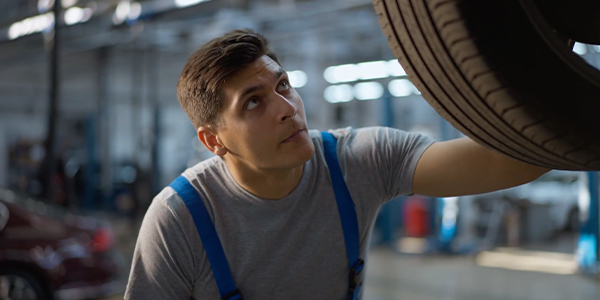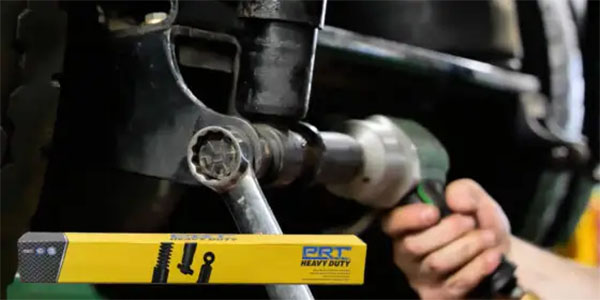CC:
What are your replacement options? One choice might be to replace the entire axle with a remanufactured or salvage unit. This can be useful if you don’t want to spend the time refreshing the axle. This approach might work if a customer is willing to wait for the axle to arrive on a pallet. The other option is to install fresh bearings and seals at your shop. This approach can eliminate the lengthy wait for a new axle and get the customer back on the road sooner.
Inspection of the bearings of a solid axle is just like any wheel bearing. First, start with the customer complaint. Some customers will give you information that might sound like a brake or drivetrain problem.
Second, perform a visual inspection of the axle. Any signs of a significant leak may indicate the unit has been run without lubricant. Look at the ends of the axle as well as the center section. Shiny leaks are a sign of an active leak. Dull or matte finish leaks might be normal seeping or weeping.
Third, check for play at the wheel. There should be no movement or play with most axles. Rotate the wheels by hand to listen and feel for any unusual sound or play.
For some axles, you will have to perform some disassembly to diagnose the condition of the axle and bearings. The first item typically removed is the cover for the differential if equipped. With the cover off, you can see the condition of the differential, ring/pinion and carrier bearings. Also, you can access the clips and bolts that secure the axles.
The next parts to come off are the wheels and brake components. With the brakes removed, you can inspect the area around the axle seals. Often, a seal will fail and the gear lube will contaminate the brake pads or the shoe for the parking brake.
You may now have a chance to remove the axle shafts. Some axles might be secured using plates or clips at the end of the axle tube. The axle shafts need to be inspected. The surfaces on the shaft that make contact with the seals and bearing need to be pristine if the axle is going to be leak-free and quiet.
The most critical part of the disassembly is removing the bearing and retainer from the shaft without damaging the axle shaft or housing. Any damage to the surfaces that the seal or bearing rides on can cause a premature failure of a new bearing.
If the surface is grooved or damaged, the axle can be repaired with a sleeve on some applications. If not, the axle should be replaced. Another option for some applications is to install a replacement bearing that repositions the bearing and seal to ride on unworn surfaces.
Under normal operating conditions, the OE-designed wheel bearing and seal can wear grooves into the axle shaft at the points of contact. This is in addition to normal wear and tear created by the bearing rollers contacting the axle shaft, which can cause pitting on the axle shaft surface. Generally, this type of wear necessitates the replacement of the axle shaft when replacing the bearing and seal. BCA Axle Shaft Repair Bearings are designed to replace the OE bearing and seal without requiring the replacement of the worn axle shaft. Axle shaft repair bearings feature a unitized design incorporating the bearing and seal into a single component.
The design of repair bearings shifts the position of the bearing and seal along the axle shaft, allowing for unworn sections of the axle shaft to be the new points of contact. BCA Axle Shaft Repair Bearings are engineered to be a direct replacement for the OE wheel bearing and seal.
Inspecting a differential and gears can be challenging. The first item to check is the ring and pinion gears. Any unusual wear to the teeth can indicate misalignment or a failed carrier or pinion bearings.
Look at the spider gears inside the differential. They should rotate freely. If the vehicle has a limited-slip differential, look up the inspection and service procedures.
The most challenging part of the repair is setting up how the ring and pinion gear mesh. The pinion gear typically has two bearings between the yoke and gear. The bearings and the crush sleeve work together to set the height and preload of the pinion gear.
The differential carrier and ring gear also have two bearings. Carrier bearings might have shims or adjusters that allow the technician to move the ring gear laterally to align properly with the pinion.
No matter the type of axle, it is critical the surfaces are free from corrosion and damage so the seal can operate as intended. Before installing the axle and seal, use a fine-grade emery cloth to clean contaminants and debris from the axle shaft and inner housing. Debris that remain in the housing may prevent the new bearing from seating properly.
Lubricate the replacement bearing and seal with clean differential oil by submerging the bearing in the oil. Install the bearing inside the axle housing with the seal facing outwards until it is fully seated. When pressing the bearing into place, be cautious not to press on the seal. Pressure should only be applied to the outer diameter of the bearing.
Re-install the axle shafts and complete the assembly procedure according to the manufacturer’s recommendations. Some axles may require new clips or fasteners. When reinstalling the axle shafts, interference with the axle splines and spider gears is a common issue, preventing an axle shaft from seating and interfering with the insertion of c-clips. If there is an issue with reinstallation of the axle shafts, this is the first thing to check.
The leading killer of solid axle wheel bearings is a failed seal. Most seals ride on the axle shaft, and they typically have a lip and a spring that holds the lip to the axle. When a seal is installed, take your time installing the axle. Splines can damage the seal and cause leaks.
The area on the axle shaft where the seal and bearings make contact is the most important. It must be free of rust and imperfections. Use only fine-grade emery paper to clean the axle shaft between the flange and the worn area.
If the surface is grooved or damaged, the axle can be repaired with a sleeve on some applications. If not, the axle should be replaced.
Make sure the breathers on the axle are not clogged. The breather on some axles acts as a PCV valve to keep pressures within a specific range so the seals can work their best as the differential heats and cools. If a breather is clogged, the heat will increase pressure in the axle. As the axle cools, a negative pressure could build up behind the seal. These changes in pressure will cause the lips of the seals to deform and leak.
After everything is assembled, make sure to use the correct gear lube. Some differentials require a specific friction modifier additive package that might be included in the gear lube, or you might have to add it separately. If the wrong lubricant is used, it might cause noise and damage the friction plates inside the limited slip mechanism.
This video is sponsored by BCA Bearings by NTN.














